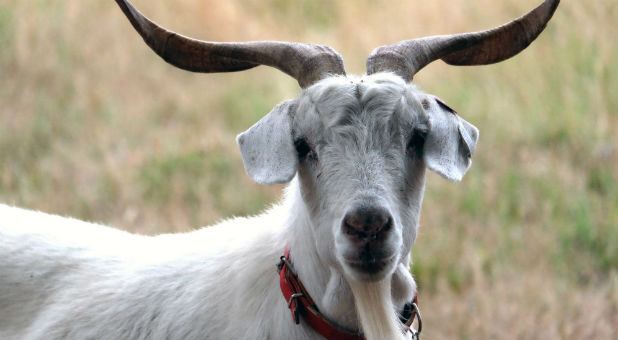Man Takes Break From Being Human to Be a Goat
Thomas Thwaites was tired of living the human life, so he decided to be a goat.
“I tried to become a goat to escape the angst inherent in being a human. The project became an exploration of how close modern technology can take us to fulfilling an ancient human dream: to take on characteristics from other animals. But instead of the ferocity of a bear, or the perspective of a bird, the characteristic most useful in modern life is something else; being present in the moment perhaps,” Thwaites said.
“Anyway I ended up in the Alps, on four legs, at a goat farm, with a prosthetic rumen strapped to my chest, eating grass and becoming a goat.”
His chronicled his grazing days in his book GoatMan: How I Took a Holiday From Being Human.
And he didn’t even have to pay for it—an arts grant paved the way for Thwaites’ endeavors.
To fully embrace his goat lifestyle, though, Thwaites made a four-legged walking frame and even ate grass. He also wanted to switch off the human parts of his brain to think like a goat.
He tells NPR:
So that was my goal, to switch off those parts of my brain. And to do that I had read about this technique called transcranial magnetic stimulation. They get basically a huge, very powerful electromagnet and put it next to your skull. The magnetic field that is generated kind of penetrates into your brain and disrupts the functioning of the synapses in that kind of bit of the brain. I thought, That sounds like a good way of turning off my ability to speak. …
So there’s this particular patch of your cortex which is very important in your ability to speak and [a neuroscientist] put his sort of huge magnet there and switched it on. And, you know, I was reciting this nursery rhyme which I know very well—in fact, “Three Billy Goats Gruff”—and he switched on this magnet and then all of a sudden I just couldn’t kind of get the words out.
Thwaites’ book on escapism comes on the heels of the puppy play documentary, The Secret Life of Human Pups, which focuses on men who live alternative lifestyles as dogs. Some even sleep in crates and relieve themselves on puppy pads.
Those who come out as animals are labeled as “trans species” or “otherkin,” according to Vice.
“Otherkin are people who identify as partially or entirely nonhuman. A dragon, a lion, a fox—you name it—there is probably someone out there who feels like they are more these things than they are human. The otherkin community can be found lurking on Reddit, Tumblr, TV Tropes and other online forums,” Vice’s Amber Roberts writes.
“The popularity of the otherkin phenomena seems to have been steadily increasing—particularly on Tumblr—since 2012. But what does it mean to truly believe you’re nonhuman? Do people genuinely wake up one day and think that they are a fox or is this just a bizarre form of escapism? Is it body dysmorphia or fantasy?”
Furthermore, Roberts says most otherkin are “suspiciously” interested in videogames and fantasy novels:
Fiona said she could see that, “for a lot of them, video games are a route into becoming otherkin.” Customizing a character, for example, is just another mode of self-fashioning. Through these video games a certain freedom is created: a virtual fantasy world, a virtual self and an outlet to be your otherkin—to be whatever you want to be.
From what I have gauged in my time speaking to otherkin, many admire certain aspects of their kintype (the animal they feel akin to) and seek to develop their own characteristics to mirror this. It’s almost like having a role model within yourself. Azurel tells me about one particular dragonkin who does his best to emulate what he thinks of dragons—he thinks of them as “wise, thoughtful, thrifty and brave”—so it’s an aspirational kind of transition. No one I speak to wants to be a goblinkin.
Thus far, Thwaites does not totally identify as a goat. He studied biology and economics at the University College London, and completed his master’s in design at the Royal College of Art, according to his publisher. He is a designer (“of a more speculative sort”) in London, where he ponders technology, science and futures research.






































